Venice's Special Events & Parades
Revised April 6, 1998
Venice's amusement operators and its merchants staged special events and parades year round to attract visitors to its amusement piers. Actually, any event or holiday was cause for celebration. Venice never failed to publicize them, for its economic base was primarily tourism and amusements. It was vital to the town's economy to attract large crowds on weekends and holidays. Visiting warships fired salutes offshore on Memorial Day, maypole dances were scheduled for the first of May, and colored eggs were passed out on Easter Sunday. Parades on all major holidays featured bands, floats, silent screen and sports celebrities. Special days were declared for any group or fraternal order that could guarantee a crowd.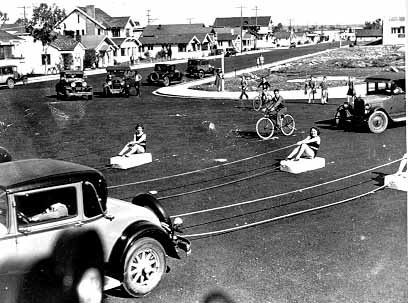
| One of Venice's unusual events were ice block races during the 1930's. |
The Venice Amusement Men's calendar of events for 1931 included the following:
|
March 17 April 5 May 30 June 7-14 July 4 July 19 August September 7 October 31 November 11 November 25 December 14-27 December 31 |
St Patrick's Day parade Easter Fashion Pageant Pacific Memorial Day Services Fiesta Week Independence Day with fireworks Annual Bathing Revue Mermaid Mardi Gras Labor Day celebration Halloween Carnival Armistice Day celebration 1st Annual Turkey Trot Christmas Fiesta New Year's Eve Frolic (24th) |
Rival Ocean Park had their own schedule of events which included a Children's Floral Parade in June, a Mardi Gras Festival in July, and a Bathing Beauty Contest at the Lick Pier.
The first bathing beauty contest in Venice was sponsored by the Los Angeles Examiner newspaper as a promotional feature in 1912. It became an annual event in which a hundred woman and young girls entered the competition at the Abbot Kinney Pier. By the 1920's it became so popular that it was moved to the beach on the north side of the pier to accommodate the several hundred thousand spectators who jammed the beach to watch. Beauty standards were quite different in those days as one can see in the photo below.
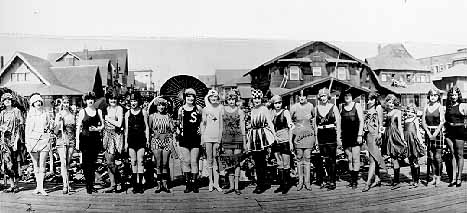
| Venice's 1923 Bathing Beauty Contest. |
The annual Male Beauty Parade and Contest was first held in 1926 at the Venice Pier in May. I'm not sure if it was a serious event or done as a spoof, but there were $500 in prizes for categories as most handsome male, most athletic male, and homeliest male. There was also a comic division. It attracted every type of male from Hollywood Sheiks with oily pomaded hair to big burly he-men; ones exceeding fat and short, and those considered very tall and lean or those who were very short.
The first statewide beauty contest for the title of Miss California was first held at the Venice Ballroom in 1932. It was held there annually through 1941 usually during the August Mardi Gras festival until World War II interrupted the festivities.
During the late 30's a group of semi-professional children who had acrobatic and gymnastic talent or could perform stunts on ponies entertained on the Venice Pier. Like all circuses they drummed up business with a circus parade complete with ornate circus wagons and animals. It began on Windward and proceeded down the pier's midway to the end of the pier where they performed to an enthusastic paying crowd.
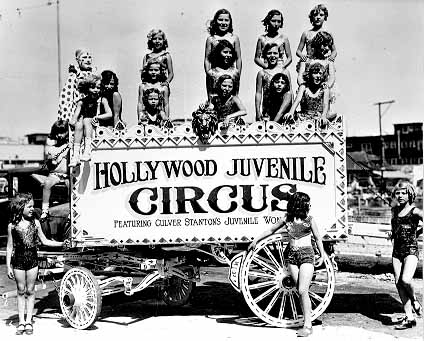
| The Hollywood Juvenile Circus performed on the Venice Pier during the late 1930's. |
Venice held its first annual Mardi Gras Festival August 16-18, 1935. The three day event featuring parades, costumes, contests and entertainment, was modeled after the New Orleans event. It was conceived by the local businessmen as a commercial enterprise that would publicize the community, attract large crowds and require cooperation of people from many segments of the populace.
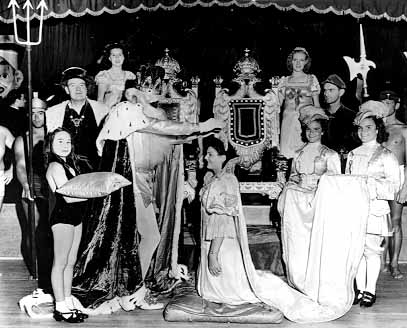
| King Neptune crowns Queen Venetia. |
It began with the arrival of King Neptune in an outrigger canoe followed by Queen Venetia's coronation and a royal procession along Ocean Front Walk. The queen read a proclamation commanding her subjects to engage in three days of fun and frivolity. The afternoon parade featured floats and costumed merrymakers wearing enormous plaster of paris heads that were manufactured in Arthur Reese's studio. Windward Avenue was roped off for a street carnival where wandering gondoliers entertained.
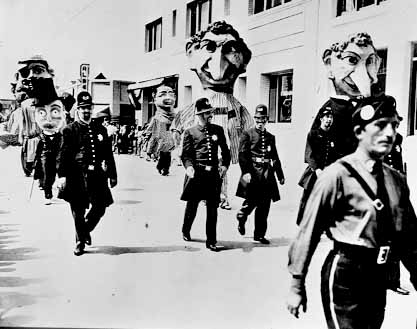
| The parade included Keystone Cops and people wearing enormous plaster of paris head gear. |
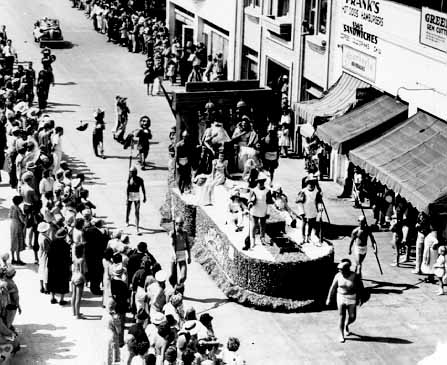
| The king and queen's float along Venice's Ocean Front Walk. - 1938 |
There was an afternoon treasure hunt for children and an evening program of aquatic events on Saturday. Sunday's Miss California beauty pageant drew huge crowds, and a Mardi Gras Ball in the evening capped the celebration.
The Mardi Gras Festival became an annual event of considerable importance prior to World War II. It became bigger and better each succeeding year and civic pride improved. By 1941 five hundred thousand people attended the expanded four day event in its final year.
Ocean Park's parades and celebrations during the twenties were an alternative to those of rival Venice, somewhat offbeat and different. They held their Mardi Gras festival and water carnival over the Fourth of July weekend. The three day festival in 1926 climaxed with a presentation of 'Ocean Park on Fire.' Apparently tourists who missed the previous pier's fiery demise could watch a reenactment of the disaster in miniature.
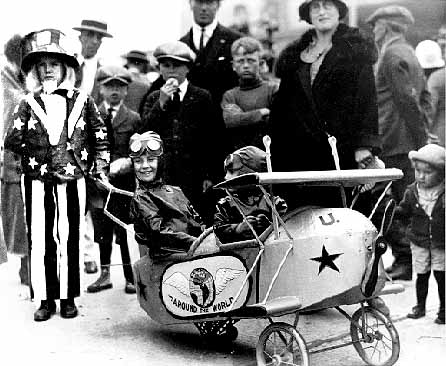
| A boy and his plane took part in the Children's Floral Parade. - 1924. |
The Children's Floral Parade began as an annual event in 1920. Hundreds of children in groups or singly competed for prizes. Costumed children rode on elaborate floats that their parents or church groups spent considerable time designing. Others tried for comic simplicity like the boy being pulled by a turtle.
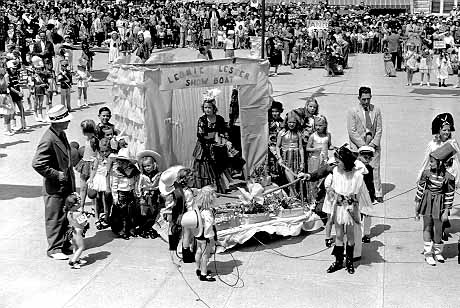
| A group sponsored this elaborate Show Boat float which was pulled by costumed children. - 1936. |
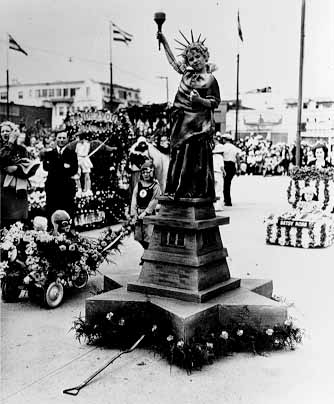
| A child rode in this scale model of the Statue of Liberty. |
The winter circus was a good visitor draw. Kinney, as early as 1906, invited the Sells-Floto Circus to make Venice their winter quarters. They entertained visitors under their big circus tent behind the Midway from December to March during the 1906, 1907 and 1910 seasons.
The Al Barnes Wild Animal Circus replaced them in 1911. The Pacific Electric Railroad arranged for the circus to come to Venice and shared the expenses to quarter them with Abbot Kinney. They arrived by rail on December 6, 1911 two weeks after the 101 Wild West Show had arrived from Oklahoma. After setting up their three-ring big-top tent behind the Race Thru the Clouds roller coaster, the circus held a street parade featuring marching elephants, caged lions and tigers in circus wagons, forty Shetland ponies, a camel, performing dogs, clowns and a troupe of monkeys. Their shows included novel acts like a boxing kangaroo, dancing bears and a singing mule. Most of the animals, wagons and equipment were housed in two nearby brick warehouses, while an open enclosure behind the roller coaster held others.
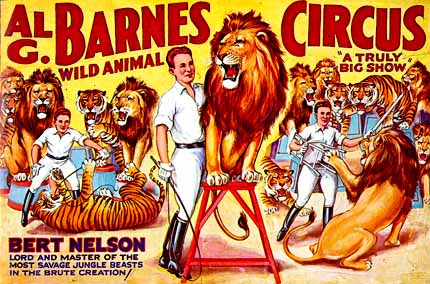
| The Barnes Circus made Venice its winter headquarters from 1911 to 1919. |
The Al Barnes Circus, except for the 1913 season continued to make Venice its winter headquarters until 1919. It was important to the town economically not only because it attracted visitors to its shows during the slow winter months, but also because initially 150 circus employees and in later years 500 circus employees made Venice their temporary winter quarters and spent money there.